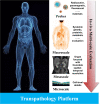Transpathology: molecular imaging-based pathology
- PMID: 33585964
- PMCID: PMC8241651
- DOI: 10.1007/s00259-021-05234-1
Transpathology: molecular imaging-based pathology
Abstract
Pathology is the medical specialty concerned with the study of the disease nature and causes, playing a key role in bridging basic researches and clinical medicine. In the course of development, pathology has significantly expanded our understanding of disease, and exerted enormous impact on the management of patients. However, challenges facing pathology, the inherent invasiveness of pathological practice and the persistent concerns on the sample representativeness, constitute its limitations. Molecular imaging is a noninvasive technique to visualize, characterize, and measure biological processes at the molecular level in living subjects. With the continuous development of equipment and probes, molecular imaging has enabled an increasingly precise evaluation of pathophysiological changes. A new pathophysiology visualization system based on molecular imaging is forming and shows the great potential to reform the pathological practice. Several improvements in "trans-," including trans-scale, transparency, and translation, would be driven by this new kind of pathological practice. Pathological changes could be evaluated in a trans-scale imaging mode; tissues could be transparentized to better present the underlying pathophysiological information; and the translational processes of basic research to the clinical practice would be better facilitated. Thus, transpathology would greatly facilitate in deciphering the pathophysiological events in a multiscale perspective, and supporting the precision medicine in the future.
Keywords: Digital pathology; Molecular imaging; Pathology; Transpathology.
Conflict of interest statement
The authors declare no competing interests.
Figures
Comment in
-
Multi-scale imaging as an essential tool for precision medicine.Eur J Nucl Med Mol Imaging. 2021 Jul;48(8):2319. doi: 10.1007/s00259-021-05367-3. Eur J Nucl Med Mol Imaging. 2021. PMID: 33885929 No abstract available.
References
-
- Abbas AK, Aster JC. Robbins and Cotran pathologic basis of disease. Elsevier/Saunders; 2015.
-
- Dudley JC, Zheng Z, McDonald T, Le LP, Dias-Santagata D, Borger D, et al. Next-generation sequencing and fluorescence in situ hybridization have comparable performance characteristics in the analysis of pancreaticobiliary brushings for malignancy. J Mol Diagn. 2016;18(1):124–130. doi: 10.1016/j.jmoldx.2015.08.002. - DOI - PubMed
Publication types
MeSH terms
Grants and funding
LinkOut - more resources
Full Text Sources
Other Literature Sources


